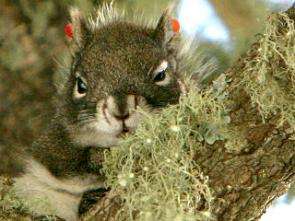Computers to save unique type of American red squirrel

UK expertise is being exported to North America to help prevent a unique type of red squirrel dying out in as little as 30 years time. Researchers from the University of Newcastle upon Tyne in England, working with The University of Arizona in the US, have developed a special computer model which in time will pinpoint the biggest threats to the rare Mount Graham Red Squirrel.
Details of the model are published in the academic journal Biological Conservation.
The Mount Graham Red Squirrel, isolated for the last 10,000 years in a small area of coniferous forest on a mountain in the Arizona desert, has a unique shape, genetic make-up and behavioural characteristics. It is a recognised subspecies and protected under the United States' Endangered Species Act. The mountain itself is known globally for the Mt. Graham International Observatory.
The British academics are applying expertise developed while working with the threatened UK red squirrel - a completely different species to the Mount Graham variety despite the similar names - in one of its last strongholds in Europe, Kielder Forest on the Scottish border. With around 10,000 red squirrels, Kielder hosts England's largest remaining population.
In Kielder, Newcastle University's Dr Peter Lurz and colleagues used the model to create a conservation strategy for the forest, assisting with planting and felling plans to help maintain a viable red squirrel population. Here, the reds' biggest threat is the introduced grey squirrel, which out-competes them for food and transfers a deadly virus.
In the US, the new computer model, which mimics population dynamics in response to different threats, will help evaluate and refocus existing efforts to save Mount Graham Red Squirrel. Although conservation measures are already in place, concerns about the animal's viability have increased as numbers have more than halved since 1999, dropping from 562 to a recent low of 214.
As with the British red squirrel, one of the Mount Graham red squirrel's threats is an introduced species of squirrel. The Abert's tree squirrel likes to eat similar types of food to the reds and also plunders the food middens they build to see them through the winter.
Other threats include damage to its habitat by insects and huge forest fires, as well as predation from birds of prey like the Mexican Spotted Owl and the Northern goshawk and mammals like the Bobcat.
Dr Peter Lurz, a research associate based at Newcastle University's Institute for Research on Environment and Sustainability, began working on the project when the Arizona University team attended an international squirrel symposium in North East England hosted by Newcastle University.
Dr Lurz said: "I think the important thing to remember is that there are multiple threats facing the Mount Graham Red Squirrel, and their survival depends on how these are best managed."
The UK-US team have so far used the model to examine potential effect of predation and the Abert's squirrel on squirrel population but are to expand on this: "The model will help identify areas where we need more research, will inform researchers' field work and will ultimately help the team to identify how future conservation efforts can best be focused," added Dr Lurz.
John Koprowski, associate professor with The University of Arizona's School of Natural Resources, and MSc student David Wood are working on the project in the US.
Prof Koprowski said current conservation methods, such as limiting access to the mountain, restricting hunting and an existing squirrel refuge did not appear to be stemming the population's decline. He said: "It's very important that we preserve the Mount Graham Red Squirrel, which has survived since the last Ice Age. Its decline in recent years is an indication of something changing on the mountain, and we need to find out what it is.
He added: "There are also important ecological reasons to save it - for example the squirrel's middens are an important source of food and habitat for chipmunks, voles, and mice, and the forest would be quite different without these animals. Moreover, if we can't save a species in a relatively controlled, isolated environment like this, it doesn't bode well for effective conservation of other species in more complex situations."
Source: University of Newcastle upon Tyne
















